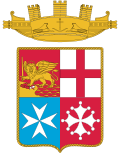You can help expand this article with text translated from the corresponding article in Italian. Click [show] for important translation instructions.
|
 | |
| History | |
|---|---|
| Name | Vulcano |
| Ordered | 2015 |
| Builder | Fincantieri |
| Launched | 2018 |
| Commissioned | March 2021 |
| In service | in active service, as of February 2024 [update] |
| Identification | Pennant number A 5335 |
| General characteristics | |
| Class & type | Vulcano-class logistic support ship |
| Displacement | 27,200 tons |
| Length | 193 m (633 ft) |
| Speed | 20 kn (37 km/h; 23 mph) |
| Complement | 235 |
| Aircraft carried | 2 EH-101 helicopters |
Vulcano (A 5335) [1] (Italian: Nave Vulcano (m)) [2] is a warship of the Italian Navy, a Vulcano-class logistic support ship, the lead ship in its class. [3] It was built as part of a joint project between Italy and France to build such ships. [4] It is a replenishment oiler auxiliary ship. [5] [6] Vulcano has the pennant number A 5335. [1]
